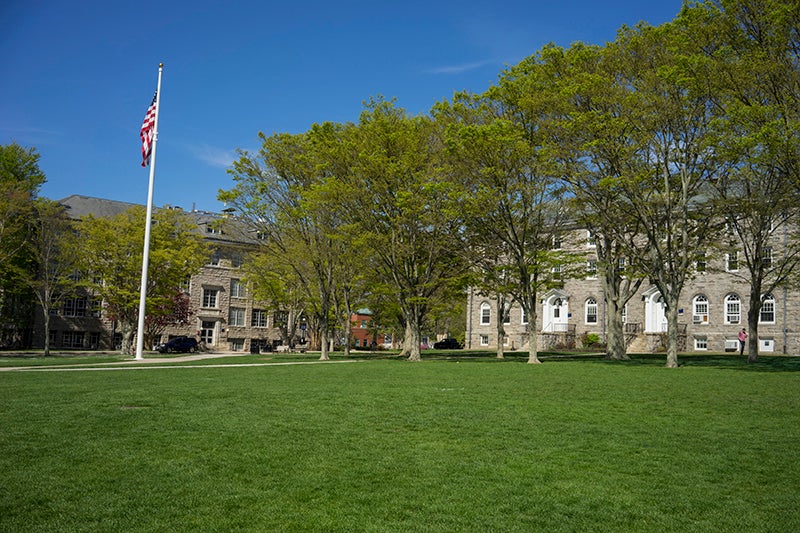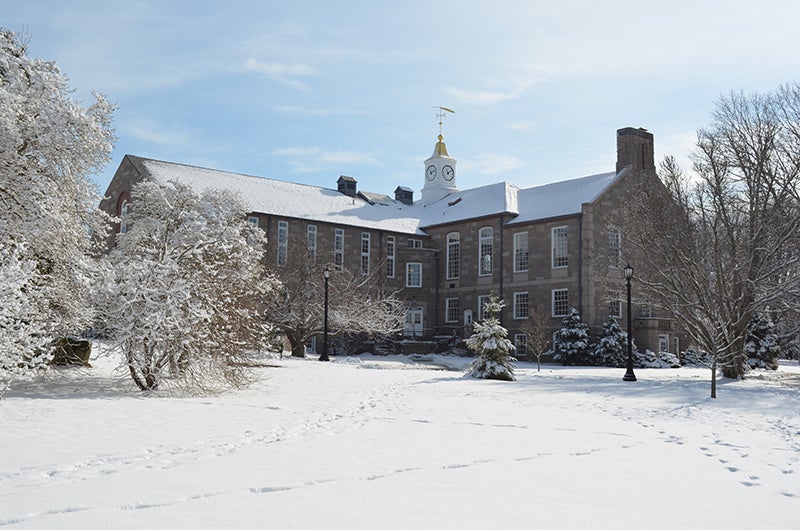KINGSTON, R.I., — January 17, 2018 —The U.S. Department of the Interior’s National Park Service has recognized the core of the University of Rhode Island’s main campus in Kingston as a historic district, adding it to the National Register of Historic Places.
This federal distinction recognizes the University of Rhode Island Historic District for its contributions to the history of education, architecture and landscape architecture, Jeffrey Emidy, acting executive director of the Rhode Island Historical Preservation & Heritage Commission, said in announcing the designation.
The National Register is the federal government’s official list of properties throughout the United States whose historical and architectural significance makes them worthy of preservation. The campus is significant for its illustration of the history of public higher education in Rhode Island and for its fine collection of academic buildings designed by locally prominent architects.

“These first-line public institutions often have great historic architecture worthy of preservation,” said Paul R. Lusignan, historian, National Register of Historic Places, National Park Service. “I will say that while many schools have buildings that share a common architectural vocabulary, few have maintained those common forms, styles and materials over time to the degree found on the URI campus. The architecture of the buildings was quite striking.”
The University of Rhode Island Historic District includes approximately 29 acres on or around the grassy, tree-lined quadrangle of the Kingston campus. The oldest structure in the district is the Oliver Watson Farmhouse (ca. 1796), part of the farmland purchased in 1888 to establish the agricultural school that would one day become URI.
The district is bound roughly by Upper College Road on the east, Campus Avenue on the south, Lower College Road and Farmhouse Road on the west, and the eastern portion of Alumni Avenue on the north. Most of the buildings in the district, particularly those that were built for academic use, are a few stories tall and are constructed of quarry-faced granite ashlar, resulting in a unified campus character. Some of that stone was harvested from now-defunct quarries on campus.
“The historic core of the URI campus has been appreciated by generations of students, faculty, staff, and administration of the University. The formal recognition of these important buildings and the landscape that contains them enhances our understanding of the important role that the University has played in the educations and careers of many from Rhode Island and beyond,” Emidy said.
“I am pleased to see our beautiful campus gain recognition and protection through this significant designation,” said URI President David M. Dooley. “We at URI have long cherished the buildings and landscape that comprises an important part of our unique identity and stature in higher education. It is gratifying to see our contributions recognized, and for that recognition to come, fittingly, at the close of our yearlong 125th Anniversary celebrations.”
The National Register nomination for URI was prepared by Rhode Island Historical Preservation & Heritage Commission architectural historian Joanna Doherty, who worked closely with J. Vernon Wyman, assistant vice president of business services at URI.
“This reinforces the important obligation we have to be preservationists and to be mindful and respectful when making improvements and modifications to these historically significant structures,” Wyman said.
List of structures in the University of Rhode Island Historic District
- Watson Farmhouse (ca. 1796)
- Taft Hall (1889)
- College Hall/Davis Hall (1890/1895)
- “Old Ben Butler” Civil War cannon (1861, brought to campus in 1892)
- Lippitt Hall (1897)
- East Hall (1909)
- Ranger Hall (1914)
- Washburn Hall (1921)
- Bliss Hall (1928)
- Edwards Hall (1928)
- Rodman Hall (1928)
- World War I Memorial Gateway (1922 and 1928)
- President’s House (1931)
- Green Hall (1937)
- Quinn Hall (1937)
- Eleanor Roosevelt Hall (1937)
- Robert L. Carothers Library and Learning Commons (1964, ’75, ’92-’93)
Historical highlights of the Kingston campus
In 1888, Rhode Island purchased the 140-acre Oliver Watson Farm in South Kingstown as the location for its R.I. State Agricultural School and Experiment Station. The Federal-style, wood-frame Watson Farmhouse (ca. 1796) survives as a relic of the property’s early agricultural history. In 1892, the institution’s name was changed to the R.I. College of Agriculture and Mechanic Arts, and two years later it was designated the state’s “land-grant” college (a status initially given to Brown).
The first phase of campus construction, dating from 1888 to 1909, reflects an emphasis on training in agriculture and applied science. Three Late Victorian-style buildings—the Agricultural Experiment Station/now known as Taft Hall (1889), College Hall/Davis Hall (1890/1895), and Lippitt Hall (1897) — were built of granite from a campus quarry. They stand on the western and northern edges of the main quadrangle (1894-97). The rectangular, open green with a double-row of trees at its perimeter was designed by Olmsted, Olmsted & Eliot, the leading American landscape architecture firm at the turn of the 20th century. A cast-iron cannon known as “Old Ben Butler” (1861) was brought to campus on May 19, 1892, the day that the state legislature passed a bill establishing the young institution’s new name: the Rhode Island College of Agriculture and Mechanic Arts.
The next phase of development, 1909 to 1941, occurred as academic programs expanded and enrollment increased at the school, which was re-named the Rhode Island State College to reflect a move toward more generalized education. Between 1909 and 1921, three buildings were erected: East Hall (1909), Ranger Hall (1914), and Washburn Hall (1921). Two more, Bliss Hall and Edwards Hall, were constructed in 1928. The interior of Edwards Hall is notable for its murals by Gino Conti, created in the mid-1930s and 1940-1941 with support from the Federal Art Project, a part of the Works Progress Administration. Covered with drywall during a 1965 renovation, three of the murals were revealed and restored as part of an interior renovation in 2010.
Other new buildings on campus included Rodman Hall (1928), originally used as an armory and gymnasium, and the President’s House, a wood-frame, Colonial Revival-style residence constructed in 1931. Three more buildings were completed in 1937 with funds from the Public Works Administration: the red brick Eleanor Roosevelt Hall (a women’s dormitory), Quinn Hall and Green Hall. The College erected two memorials to those who served in World War I, both located near the intersection of Upper College Road and Campus Avenue: a granite boulder with a bronze plaque, erected in 1922, and a granite gateway to the campus, constructed in 1928.
Apart from Federal funding, the College’s financial resources during the Great Depression were severely limited. The State budget was cut, and voters rejected a 1938 State bond referendum that would have provided over $1 million for building and infrastructure projects. Following the end of World War II, students whose educations had been disrupted by the war returned to campus, and veterans subsidized by the G.I. Bill enrolled in record numbers. By 1951, a new wave of construction was already underway when the General Assembly passed a bill to reorganize the State College as the University of Rhode Island. Even as changes occurred, such as the construction of the University Library (now Robert L. Carothers Library and Learning Commons), the historic core of the campus remained intact, embodying the university’s origins as a land-grant school and its growth in the first half of the 20th century.
Additional media contact:
Sarah Zurier, sarah.zurier@preservation.ri.gov
401-222-4142
R.I. Historical Preservation & Heritage Commission

